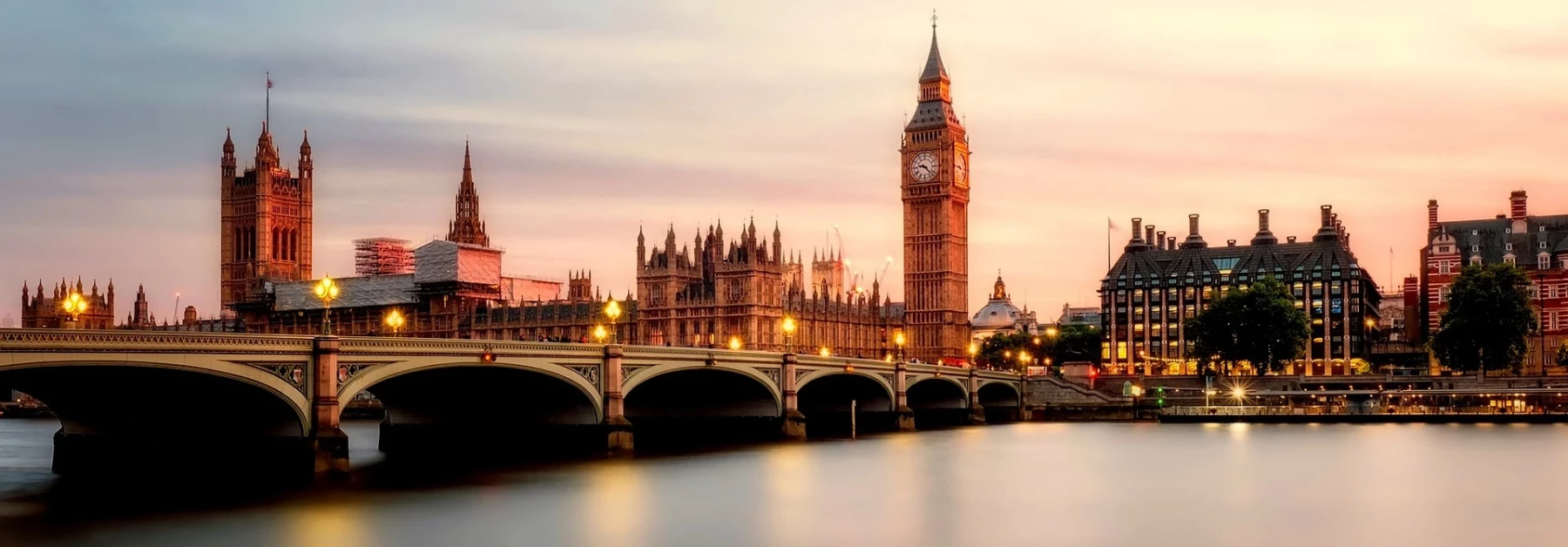Les 18 choses incontournables à faire à Londres
Dernière mise à jour : 26/05/2024 15:42Sommaire
- A visiter
-
- 1 - Big Ben et le Parlement (le Palais de Westminster)
- 2 - le London Tower Bridge
- 3 - La Tour de Londres
- 4 - Buckingham Palace et le Changing of the Guard
- 5 - Le London Eye pour une vue panoramique sur la ville
- 6 - L’Abbaye de Westminster
- 7 - Le British Museum
- 8 - La National Gallery
- 9 - La Tate Modern
- 10 - Quartier Soho
- 11 - Quartier Camden Town
- 12 - Quartier Notting Hill
- 13 - Hyde Park
- 14 - Greenwich Park
- 15 - La gastronomie britanniques
- 16 - Faire une croisière sur la Tamise
- 17 - Les studios Harry Potter
- 18 - Faire une excursion vers le château de Windsor
- Londres - Où Loger ?
- Londres - Comment se déplacer ?
- Londres - Meilleure période
Londres est la capitale du Royaume-Uni et l'une des villes les plus importantes et influentes du monde. Située dans le sud-est de l'Angleterre, le long de la rivière Thames, Londres est renommée pour sa richesse historique, sa diversité culturelle, son dynamisme économique et ses attractions touristiques.
La ville offre une variété d'attractions emblématiques, telles que le Palais de Buckingham, la Tour de Londres, le Parlement britannique avec la célèbre tour de l'horloge Big Ben, la Cathédrale Saint-Paul, le London Eye, et bien sûr, le quartier animé du West End, connu pour ses théâtres et ses spectacles.
Londres est également un centre culturel majeur, abritant de nombreux musées et galeries d'art de renommée mondiale, tels que le British Museum, la National Gallery, et le Tate Modern.
La ville est également célèbre pour sa diversité culturelle, avec des communautés provenant du monde entier, ce qui se reflète dans sa cuisine, sa musique, ses festivals et ses événements culturels.
En somme, Londres est une ville dynamique et cosmopolite, où l'histoire rencontre la modernité, offrant une expérience riche et diversifiée à ses habitants et à ses visiteurs.
1 - Big Ben et le Parlement (le Palais de Westminster)
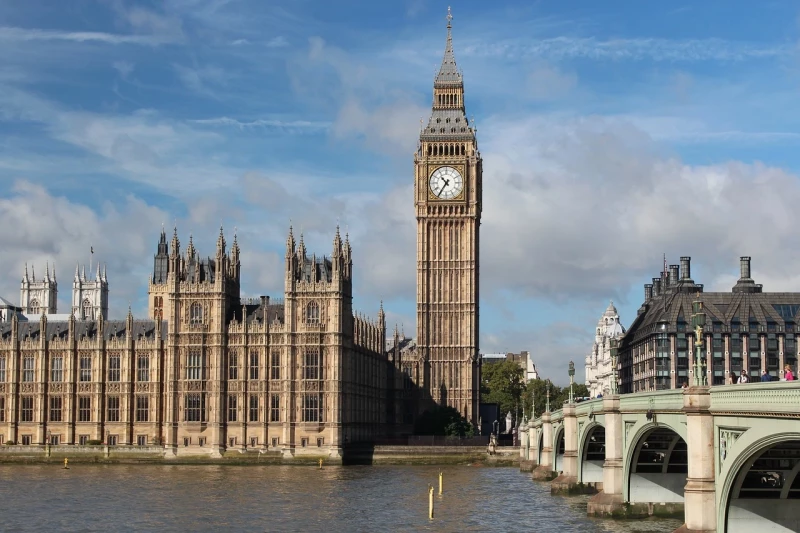
Big Ben et le Parlement, également connu sous le nom de Palais de Westminster, sont deux des symboles les plus emblématiques de Londres et du Royaume-Uni dans son ensemble.
Le Parlement du Royaume-Uni siège dans le Palais de Westminster, situé sur les rives de la Tamise. Le bâtiment abrite les deux chambres du Parlement britannique : la Chambre des communes et la Chambre des lords. Il est au cœur de la vie politique britannique et joue un rôle central dans le processus législatif du pays.
Big Ben, bien que souvent utilisé pour désigner la tour de l'horloge, fait en réalité référence à la grande cloche à l'intérieur de la tour. La tour de l'horloge abrite également une horloge emblématique, l'une des plus célèbres au monde. Big Ben est l'un des monuments les plus reconnaissables de Londres et est souvent associé à l'horloge du Palais de Westminster.
La combinaison de Big Ben et du Palais de Westminster est un symbole puissant de la démocratie britannique et de l'histoire riche du pays. Ces deux structures attirent des millions de visiteurs du monde entier chaque année et continuent de capturer l'imagination collective.
 Nos astuces pour tirer le meilleur parti de votre expérience.
Nos astuces pour tirer le meilleur parti de votre expérience.
Visiter Big Ben et le Parlement (le Palais de Westminster) à Londres peut être une expérience passionnante. Voici quelques astuces pour en tirer le meilleur parti :
-
Planifiez à l'avance : Vérifiez les horaires d'ouverture et les possibilités de visites guidées. Assurez-vous de vérifier s'il y a des fermetures exceptionnelles ou des travaux de rénovation en cours qui pourraient affecter votre visite.
-
Réservez vos billets à l'avance : Si vous prévoyez de visiter l'intérieur du Parlement ou de monter dans la tour de l'horloge de Big Ben, il est recommandé de réserver vos billets à l'avance. Les billets pour les visites guidées sont souvent en demande et peuvent se vendre rapidement.
-
Arrivez tôt : Pour éviter les foules, essayez de planifier votre visite tôt le matin. Cela vous permettra également d'avoir de meilleures chances de réserver des billets pour les visites guidées.
-
Soyez prêt pour la sécurité : Comme pour la plupart des sites touristiques majeurs, il y aura probablement des contrôles de sécurité à l'entrée du Parlement. Assurez-vous de respecter les directives de sécurité et d'arriver suffisamment tôt pour passer par les contrôles sans précipitation.
-
Profitez des vues extérieures : Même si vous ne pouvez pas visiter l'intérieur du Parlement ou monter dans la tour de l'horloge, les vues extérieures du bâtiment et de Big Ben depuis le pont de Westminster sont spectaculaires et valent la peine d'être appréciées.
-
Prenez une visite guidée : Si vous avez la possibilité, envisagez de participer à une visite guidée. Les guides peuvent fournir des informations historiques et des détails intéressants que vous pourriez manquer autrement.
-
Explorez les environs : Après votre visite, profitez-en pour explorer les environs. Des attractions telles que l'Abbaye de Westminster, le London Eye et les rives de la Tamise offrent une multitude d'options pour prolonger votre journée de découverte.
En suivant ces astuces, vous devriez être en mesure de profiter pleinement de votre visite à Big Ben et au Parlement, en créant des souvenirs durables de votre séjour à Londres.
2 - le London Tower Bridge
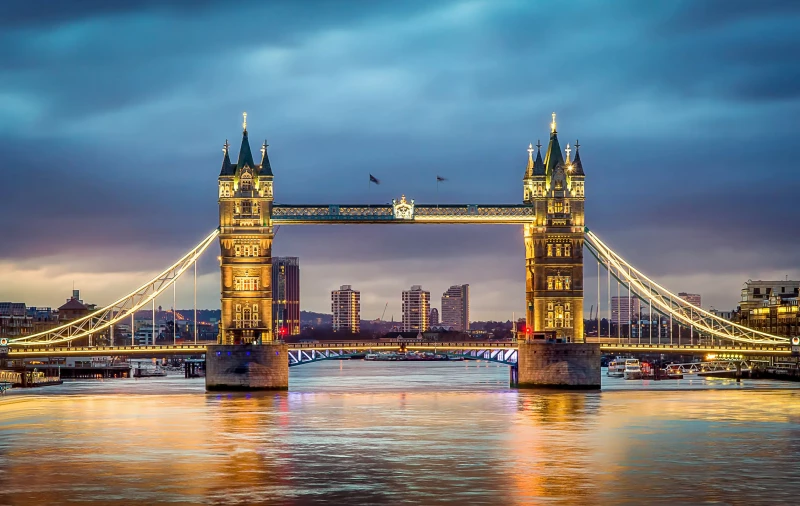
Le London Tower Bridge, souvent simplement appelé Tower Bridge, est l'un des monuments les plus emblématiques de Londres, en Angleterre. Situé au-dessus de la Tamise, il s'agit d'un pont basculant et suspendu combiné, ce qui signifie qu'il peut être levé pour permettre le passage de grands navires en dessous.
La construction du pont a débuté en 1886 et s'est achevée en 1894. Il a été conçu par Sir Horace Jones et réalisé par l'ingénieur Sir John Wolfe Barry, avec d'importantes contributions de l'architecte George D. Stevenson. Le Tower Bridge se caractérise par ses deux tours distinctives, reliées par deux passerelles offrant une vue imprenable sur la ville.
La palette de couleurs du pont, bleu et blanc, a été choisie pour compléter la Tour de Londres voisine. Au fil des ans, le Tower Bridge est devenu un symbole emblématique de Londres et est l'une des attractions touristiques les plus populaires de la ville. Il constitue également un lien de transport important, reliant le quartier de Tower Hamlets au nord de la rivière à Southwark au sud.
Outre sa fonction pratique, le Tower Bridge est également célèbre pour son fonctionnement mécanique, avec ses bascules pouvant être levées jusqu'à un angle de 86 degrés pour permettre le passage des navires. Bien qu'il ait été à l'origine alimenté par la vapeur, il est maintenant actionné électriquement.
Dans l'ensemble, le Tower Bridge témoigne de l'ingéniosité de l'ingénierie victorienne et reste un symbole aimé de l'histoire riche et du patrimoine architectural de Londres.
3 - La Tour de Londres
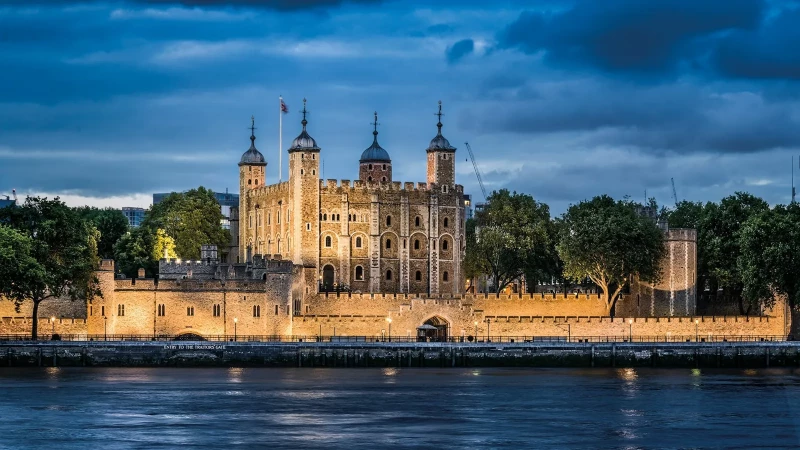
La Tour de Londres est une forteresse historique située sur la rive nord de la Tamise, dans le centre de Londres, en Angleterre. Elle a été fondée au XIe siècle par Guillaume le Conquérant et a depuis joué de nombreux rôles au fil des siècles : résidence royale, prison, palais, arsenal, trésorerie et même zoo.
La Tour de Londres est célèbre pour ses imposants murs de pierre blanche et ses tours, dont la plus connue est la tour Blanche (White Tower), qui a donné son nom à l'ensemble de la forteresse. Construite au début du XIe siècle, la tour Blanche est l'un des exemples les plus remarquables de l'architecture normande en Angleterre.
Au fil des ans, la Tour de Londres a acquis une réputation sinistre en tant que prison célèbre, où de nombreux personnages historiques ont été emprisonnés, exécutés ou ont mystérieusement disparu. Parmi les prisonniers les plus célèbres figurent Anne Boleyn, épouse d'Henri VIII, et la reine Élisabeth I avant son accession au trône.
Aujourd'hui, la Tour de Londres est une attraction touristique majeure, accueillant des millions de visiteurs chaque année. Les visiteurs peuvent explorer les différentes parties de la forteresse, découvrir ses histoires fascinantes, admirer les joyaux de la Couronne britannique et même assister à des reconstitutions historiques. La Tour de Londres est également classée au patrimoine mondial de l'UNESCO depuis 1988.
4 - Buckingham Palace et le Changing of the Guard
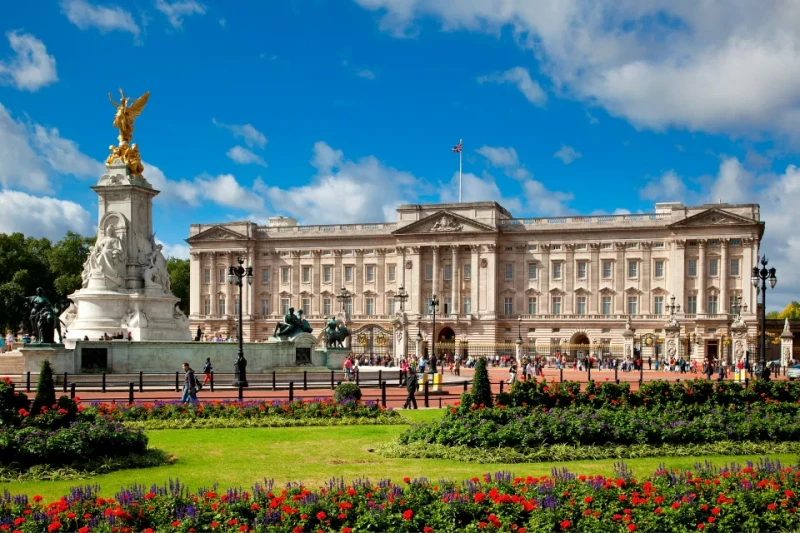
Buckingham Palace est la résidence officielle du monarque britannique à Londres. Il sert à la fois de siège administratif et de l'une des principales résidences royales. Situé dans la Cité de Westminster, Buckingham Palace est souvent au centre des événements d'État et de l'hospitalité royale.
L'une des cérémonies les plus célèbres associées à Buckingham Palace est la relève de la garde. Cet événement cérémonial se déroule à l'extérieur du palais et implique un échange formel des fonctions entre la vieille et la nouvelle garde. Les gardes sont généralement vêtus de tuniques rouges traditionnelles et de bonnets d'ours, créant un spectacle saisissant pour les visiteurs et les touristes.
La relève de la garde se déroule généralement quotidiennement pendant les mois les plus chauds et les jours alternés pendant l'hiver. Cependant, l'horaire peut varier, il est donc conseillé de consulter le site officiel ou de s'informer localement pour obtenir les informations les plus à jour si vous prévoyez d'assister à cette cérémonie emblématique. C'est une attraction populaire pour les touristes visitant Londres, offrant un aperçu de la pompe et de la cérémonie des traditions royales britanniques.
 Nos astuces pour tirer le meilleur parti de votre expérience.
Nos astuces pour tirer le meilleur parti de votre expérience.
Si vous envisagez de visiter Buckingham Palace et d'assister à la relève de la garde à Londres, voici quelques astuces utiles :
-
Vérifiez les horaires : Assurez-vous de consulter les horaires de la relève de la garde sur le site officiel de la famille royale britannique ou dans d'autres sources fiables. Les horaires peuvent varier en fonction des saisons et des événements spéciaux.
-
Arrivez tôt : La relève de la garde est une attraction très populaire et les spectateurs commencent souvent à se rassembler bien avant le début de la cérémonie pour obtenir les meilleures places. Arriver tôt vous garantira une meilleure vue.
-
Choisissez le bon endroit : Il existe plusieurs endroits autour de Buckingham Palace où vous pouvez observer la relève de la garde. Le Victoria Memorial, l'avant du palais et le Mall sont parmi les endroits les plus recommandés.
-
Respectez les règles : Pendant la cérémonie, assurez-vous de respecter les règles et les instructions des gardes et des autorités locales. Évitez de traverser les cordons de sécurité ou de perturber le déroulement de la cérémonie.
-
Restez informé : Les horaires et les détails de la relève de la garde peuvent parfois changer en raison de circonstances imprévues. Restez informé en consultant les mises à jour sur les réseaux sociaux, les sites web officiels ou en demandant aux habitants ou aux agents de sécurité sur place.
-
Combinez avec une visite du palais : Si Buckingham Palace est ouvert aux visites pendant votre séjour, envisagez de combiner votre expérience de la relève de la garde avec une visite du palais lui-même. Cela vous permettra de profiter pleinement de votre temps dans la région et d'avoir une expérience royale complète.
En suivant ces astuces, vous serez bien préparé pour profiter pleinement de votre visite à Buckingham Palace et de la relève de la garde à Londres.
5 - Le London Eye pour une vue panoramique sur la ville
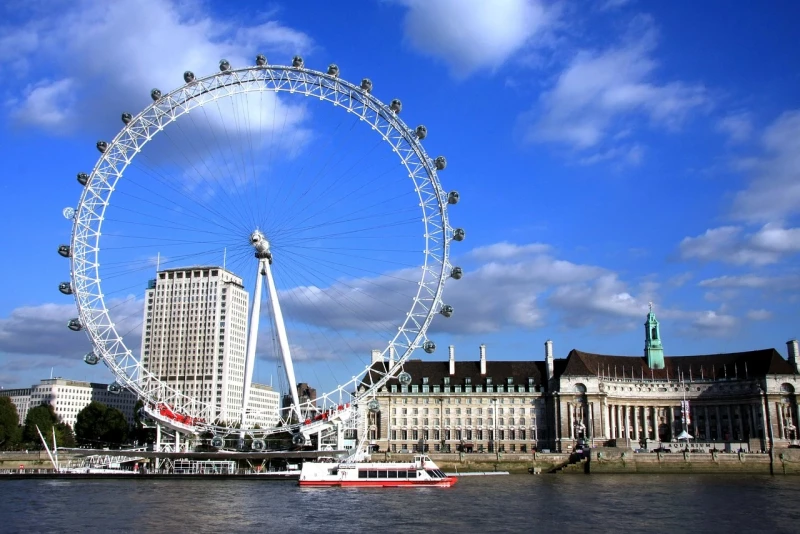
Le London Eye, également connu sous le nom de Millennium Wheel, est une grande roue d'observation située sur la rive sud de la Tamise à Londres, en Angleterre. Elle s'élève à une hauteur de 135 mètres et a un diamètre de 120 mètres, ce qui en fait l'une des plus grandes roues d'observation au monde.
Le London Eye a été initialement construit pour célébrer le nouveau millénaire et a été officiellement ouvert au public le 9 mars 2000. Depuis lors, il est devenu l'un des monuments les plus emblématiques et les attractions touristiques les plus populaires de Londres, offrant des vues panoramiques époustouflantes sur le skyline de la ville.
Chaque capsule fermée du London Eye peut accueillir jusqu'à 25 personnes, et une rotation complète prend environ 30 minutes. Pendant le trajet, les visiteurs peuvent profiter de vues imprenables sur des monuments célèbres de Londres tels que Big Ben, le Parlement, la cathédrale Saint-Paul, Buckingham Palace et le Shard.
Le London Eye est ouvert toute l'année, mais il est conseillé de vérifier les horaires d'ouverture et de réserver des billets à l'avance, surtout pendant les saisons touristiques, afin d'éviter les longues files d'attente. De plus, le London Eye organise souvent des événements spéciaux, tels que les célébrations du Nouvel An et des événements privés.
Dans l'ensemble, un tour sur le London Eye offre une expérience inoubliable et une perspective unique sur la métropole animée de Londres, ce qui en fait une attraction incontournable pour les touristes et les habitants.
6 - L’Abbaye de Westminster
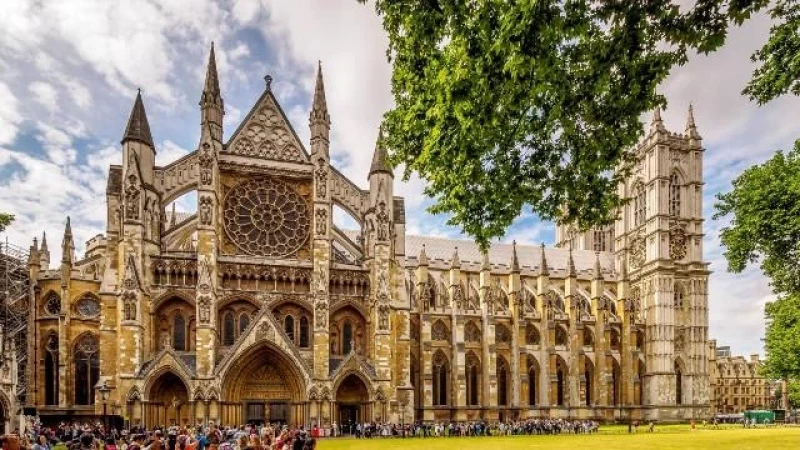
L'Abbaye de Westminster, officiellement connue sous le nom de Collegiate Church of St. Peter at Westminster, est une église historique située dans la Cité de Westminster à Londres, en Angleterre. Elle est renommée pour son architecture gothique spectaculaire et son importance historique en tant que lieu de couronnement et de sépulture des monarques britanniques.
L'histoire de l'abbaye remonte à l'époque médiévale, avec la fondation d'une église bénédictine en 960. Cependant, l'abbaye actuelle a été principalement construite entre les XIe et XVIe siècles. Son architecture impressionnante comprend notamment la célèbre voûte en éventail du XIIIe siècle.
L'Abbaye de Westminster a été le lieu de nombreux couronnements royaux depuis l'époque de Guillaume le Conquérant en 1066. Elle a également accueilli de nombreux mariages royaux, dont celui du Prince William et de Catherine Middleton en 2011.
En plus de son rôle cérémonial, l'abbaye abrite de nombreux monuments commémoratifs, tombeaux royaux et mémoriaux, dont le célèbre Poets' Corner, où reposent de nombreux écrivains et poètes britanniques éminents.
L'abbaye est ouverte aux visiteurs, qui peuvent explorer son architecture remarquable, découvrir son histoire fascinante et admirer ses trésors artistiques. Des visites guidées sont disponibles pour ceux qui souhaitent en apprendre davantage sur les détails historiques et architecturaux de ce lieu emblématique de Londres.
7 - Le British Museum
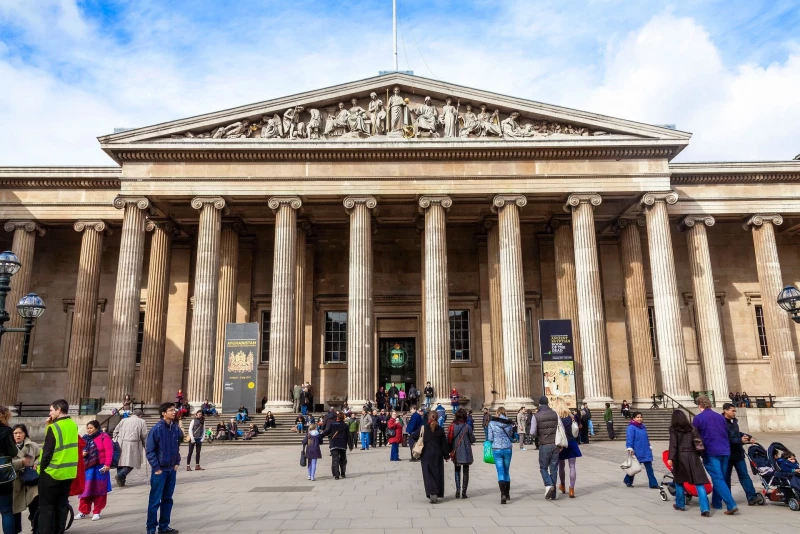
Le British Museum est l'un des plus grands et des plus prestigieux musées du monde, situé à Londres, en Angleterre. Fondé en 1753, il abrite une vaste collection d'artefacts et d'œuvres d'art provenant de différentes parties du monde et de différentes périodes de l'histoire humaine.
Voici quelques points clés à retenir sur le British Museum :
-
Collections : Le British Museum possède plus de huit millions d'objets, couvrant une gamme variée de disciplines, notamment l'archéologie, l'anthropologie, l'art, l'histoire et la culture. Les collections comprennent des trésors de l'Égypte ancienne, de la Grèce antique, de Rome, de la Mésopotamie, de l'Asie, de l'Afrique, de l'Amérique et bien d'autres.
-
Bâtiment : Le bâtiment principal du British Museum est un exemple d'architecture néoclassique, conçu par l'architecte Sir Robert Smirke. Il est situé dans le quartier de Bloomsbury à Londre et présente une grande cour centrale entourée de galeries.
-
Gratuité : L'entrée au British Museum est gratuite pour tous les visiteurs, bien que des frais puissent s'appliquer pour certaines expositions temporaires. Cela en fait une attraction très populaire auprès des touristes et des habitants de Londres.
-
Points forts : Parmi les pièces les plus célèbres du musée, on trouve la Pierre de Rosette, les frises du Parthénon, les momies égyptiennes, la statue du Dieu Râ-Horakhty, le masque funéraire de Sutton Hoo, et bien d'autres.
-
Activités et visites : Le British Museum propose des visites guidées gratuites, des activités pour les familles, des conférences et des ateliers tout au long de l'année. Il vaut la peine de consulter le programme des événements pour enrichir votre visite.
-
Conseils pratiques : Étant donné la taille et la richesse des collections, il est recommandé de planifier votre visite à l'avance et de choisir quelques points d'intérêt spécifiques à explorer. Assurez-vous également d'arriver tôt pour éviter les foules, surtout les jours de grande affluence.
En somme, le British Museum est une destination incontournable pour les amateurs d'histoire, d'art et de culture, offrant une expérience immersive et éducative pour les visiteurs de tous âges et de tous horizons.
8 - La National Gallery
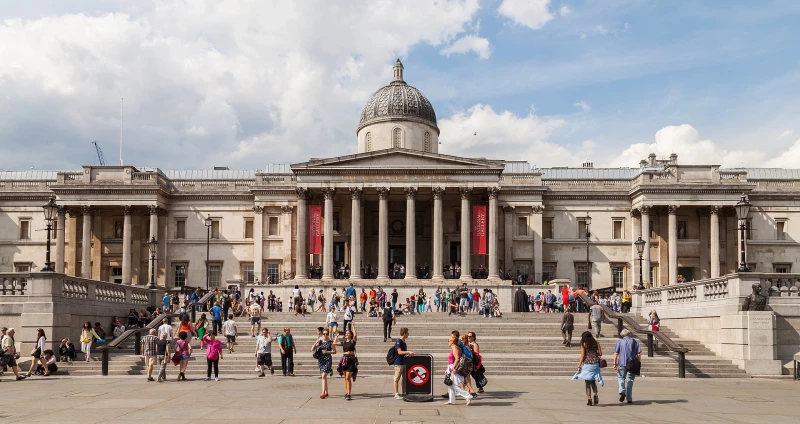
La National Gallery est un musée d'art situé à Trafalgar Square, au cœur de Londres, en Angleterre. Fondée en 1824, elle abrite une vaste collection de plus de 2 300 peintures datant du milieu du XIIIe siècle jusqu'aux années 1900. Le musée se concentre principalement sur les peintures européennes, avec des œuvres représentant différents mouvements artistiques et styles.
Voici quelques points clés sur la National Gallery :
-
Collections : La collection de la National Gallery comprend des chefs-d'œuvre d'artistes renommés tels que Leonardo da Vinci, Vincent van Gogh, Claude Monet, Michel-Ange, Rembrandt, Johannes Vermeer, et bien d'autres. Les peintures couvrent une large gamme de genres, notamment des scènes religieuses, des portraits, des paysages, des natures mortes et des sujets historiques.
-
Bâtiment : Le bâtiment principal de la National Gallery est une structure néoclassique emblématique conçue par l'architecte William Wilkins. Il présente de grandes salles et galeries ornées de décorations sophistiquées, offrant un cadre approprié pour les œuvres d'art exposées.
-
Entrée gratuite : Comme de nombreux musées à Londres, l'entrée à la National Gallery est gratuite pour tous les visiteurs. Cette accessibilité en fait une destination populaire pour les amateurs d'art, les étudiants et les touristes.
-
Visites guidées et événements : La National Gallery propose des visites guidées, des conférences, des ateliers et des expositions spéciales tout au long de l'année. Ces événements offrent des opportunités aux visiteurs de approfondir leur compréhension des œuvres d'art et de leur contexte historique.
-
Conseils pratiques : Étant donné l'ampleur de la collection, il est conseillé de planifier votre visite à l'avance et de privilégier les peintures ou les artistes que vous souhaitez voir. Le site Web du musée fournit des informations sur les expositions en cours, les horaires d'ouverture et les directives pour les visiteurs.
-
Cafés et boutiques : La National Gallery dispose de plusieurs cafés et d'une boutique où les visiteurs peuvent se détendre, prendre des rafraîchissements et acheter des souvenirs liés à la collection du musée.
En résumé, la National Gallery est un monument culturel à Londres, offrant une riche et diverse gamme de trésors artistiques qui attirent des visiteurs de tous âges et de tous horizons. Que vous soyez un passionné d'art chevronné ou un admirateur occasionnel, une visite à la National Gallery est sûre d'être une expérience enrichissante.
9 - La Tate Modern
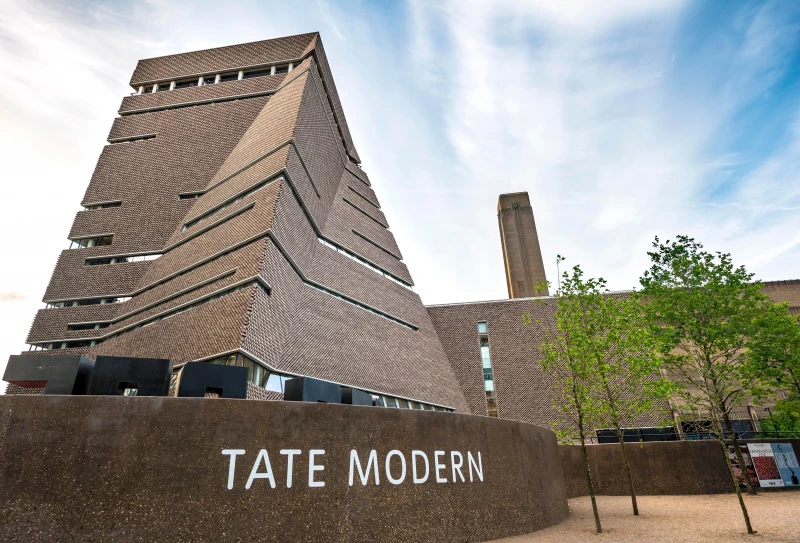
La Tate Modern est un musée d'art moderne et contemporain situé à Londres, en Angleterre. Il est l'une des quatre galeries de la Tate, avec la Tate Britain, la Tate Liverpool et la Tate St Ives. La Tate Modern est logée dans une ancienne centrale électrique sur les rives de la Tamise, dans le quartier de Bankside.
Voici quelques points clés à connaître sur la Tate Modern :
-
Collections : La Tate Modern abrite une vaste collection d'œuvres d'art moderne et contemporain, couvrant une gamme diversifiée de médiums artistiques, y compris la peinture, la sculpture, la photographie, la vidéo, l'installation et bien plus encore. Les œuvres exposées proviennent d'artistes du monde entier, avec une attention particulière portée aux artistes britanniques et internationaux les plus influents.
-
Bâtiment : La Tate Modern est logée dans l'ancienne centrale électrique de Bankside, conçue par l'architecte Sir Giles Gilbert Scott et achevée en 1963. La structure industrielle emblématique a été convertie en galerie d'art par les architectes suisses Herzog & de Meuron, et elle est devenue un symbole de l'architecture contemporaine de Londres.
-
Expositions et Installations : La Tate Modern organise régulièrement des expositions temporaires présentant le travail d'artistes émergents et établis, ainsi que des installations d'art contemporain spécialement commandées pour les espaces de la galerie. Ces expositions offrent aux visiteurs une perspective stimulante sur les tendances et les développements actuels de l'art contemporain.
-
Événements et Programmes : En plus des expositions, la Tate Modern propose une gamme d'événements, de discussions, de conférences, de projections de films et d'ateliers destinés à élargir et enrichir l'expérience des visiteurs. Ces programmes offrent des occasions uniques d'engagement avec l'art et la culture contemporains.
-
Boutiques et Restaurants : La Tate Modern abrite des boutiques de cadeaux proposant une gamme de produits artistiques et culturels, ainsi que des restaurants et cafés offrant une cuisine délicieuse et une vue imprenable sur la Tamise et le panorama urbain de Londres.
En somme, la Tate Modern est un lieu incontournable pour les amateurs d'art moderne et contemporain, offrant une expérience immersive et stimulante au cœur de la capitale britannique. Que vous soyez un connaisseur d'art passionné ou simplement curieux de découvrir de nouvelles perspectives artistiques, une visite à la Tate Modern promet d'être une expérience mémorable.
10 - Quartier Soho
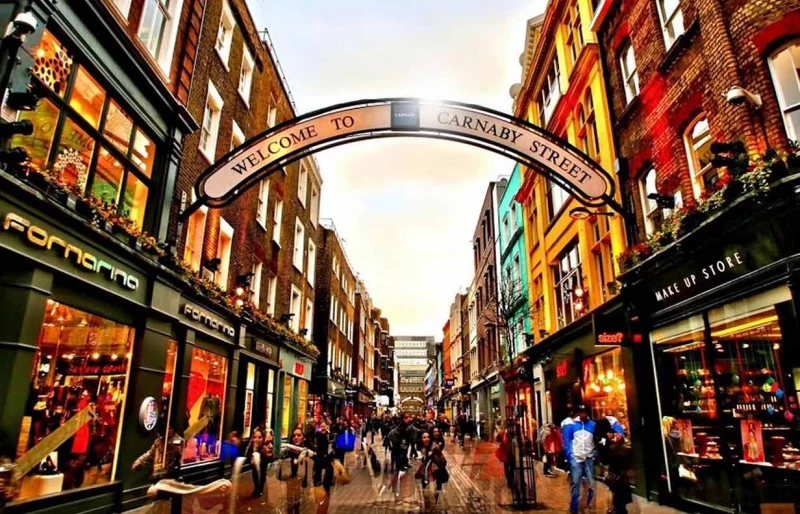
Soho est un quartier dynamique et diversifié situé dans le quartier de West End à Londres, en Angleterre. Connu pour son atmosphère animée, sa diversité culturelle et son histoire riche, Soho est depuis longtemps un centre de divertissement, de vie nocturne et d'industries créatives.
Voici quelques caractéristiques et attractions clés de Soho :
-
Divertissement : Soho est réputé pour ses options de divertissement, notamment les théâtres, les salles de concert, les clubs de comédie et les cinémas. Le quartier a un riche patrimoine théâtral, avec des lieux célèbres tels que le London Palladium, le Ronnie Scott's Jazz Club et le Soho Theatre.
-
Vie nocturne : Soho est synonyme de vie nocturne, avec une grande variété de bars, pubs, clubs et lieux nocturnes. Des pubs anglais traditionnels aux bars à cocktails branchés et aux clubs underground, il y en a pour tous les goûts à Soho après la tombée de la nuit.
-
Restauration : Soho est un haut lieu de la gastronomie, avec un mélange éclectique de restaurants, de cafés, de stands de street food et de restaurants représentant des cuisines du monde entier. Que vous ayez envie de cuisine italienne, chinoise, indienne ou britannique traditionnelle, vous trouverez de nombreuses options à Soho pour satisfaire vos papilles.
-
Shopping : Soho offre une expérience shopping diversifiée, avec un mélange de boutiques indépendantes, de magasins vintage, de grands détaillants de mode et de boutiques originales. De la mode de créateurs aux souvenirs uniques en passant par les produits artisanaux, Soho est un paradis pour les acheteurs.
-
Diversité culturelle : Soho a une longue histoire de diversité culturelle et de tolérance, avec des communautés de divers horizons coexistant harmonieusement. Cette diversité se reflète dans la vie de rue animée du quartier, sa cuisine multiculturelle et son expression artistique.
-
Monuments : Soho abrite plusieurs monuments et attractions notables, dont l'emblématique Carnaby Street, Chinatown, Leicester Square, ainsi que les rues animées de Shaftesbury Avenue et Dean Street.
En résumé, Soho est un quartier dynamique et excitant qui offre quelque chose pour tout le monde, que vous soyez intéressé par le divertissement, la restauration, le shopping ou simplement l'atmosphère d'un des quartiers les plus emblématiques de Londres.
11 - Quartier Camden Town
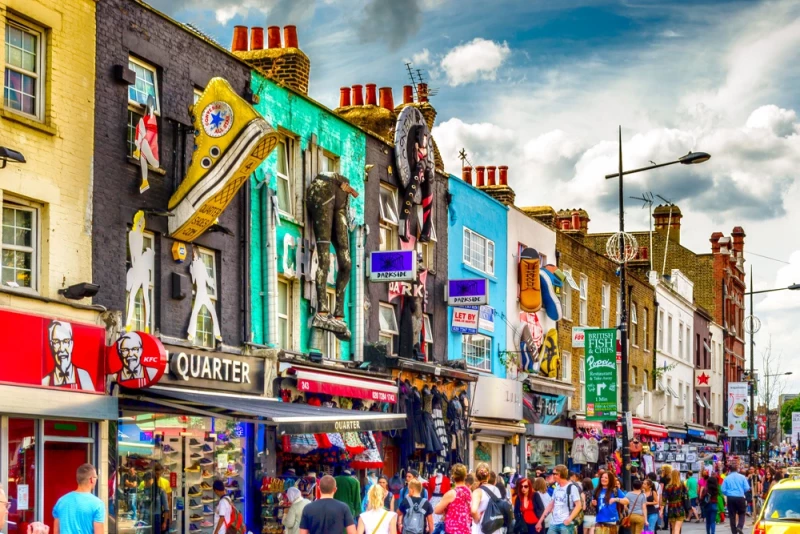
Camden Town est un quartier éclectique et excentrique situé dans le nord de Londres, en Angleterre. Connu pour son ambiance alternative, sa scène artistique vibrante, ses marchés animés et son atmosphère bohème, Camden Town attire les visiteurs du monde entier en quête de culture et d'originalité.
Voici quelques caractéristiques et attractions clés de Camden Town :
-
Marchés : Camden Market est l'une des principales attractions de la région, offrant une variété de stands et de boutiques vendant tout, des vêtements vintage et de la musique aux objets d'artisanat et de design alternatif. Les marchés de Camden sont le lieu idéal pour dénicher des trouvailles uniques et découvrir de nouveaux talents artistiques.
-
Vie nocturne : Camden Town est réputé pour sa vie nocturne animée, avec une multitude de pubs, de bars, de clubs et de salles de concert proposant une gamme diversifiée de musique live, allant du rock indépendant au reggae en passant par l'électronique. Le célèbre Roundhouse, une ancienne salle de locomotive transformée en lieu de spectacles, est un incontournable pour les amateurs de musique.
-
Street Art : Les rues de Camden Town sont parsemées d'œuvres d'art de rue colorées et expressives, créées par des artistes locaux et internationaux. Des graffitis aux installations artistiques, l'art urbain fait partie intégrante de l'identité artistique et culturelle de Camden.
-
Cuisine internationale : Camden Town propose une grande variété de restaurants, cafés et stands de street food offrant une cuisine du monde entier. Que vous recherchiez des plats exotiques, des spécialités internationales ou des plats de rue authentiques, vous trouverez de tout à Camden, souvent à des prix abordables.
-
Canal de Regent's : Le quartier de Camden est bordé par le pittoresque canal de Regent's, offrant aux visiteurs la possibilité de se promener le long de ses berges, de faire du vélo ou même de faire une croisière en bateau. Le canal offre une évasion tranquille du tumulte de la ville tout en offrant des vues pittoresques et une ambiance décontractée.
En résumé, Camden Town est un quartier éclectique et dynamique où l'originalité et la diversité règnent en maître. Que vous soyez amateur de shopping, de musique, d'art ou simplement de flânerie, Camden Town offre une expérience unique et mémorable à tous ceux qui le visitent.
12 - Quartier Notting Hill
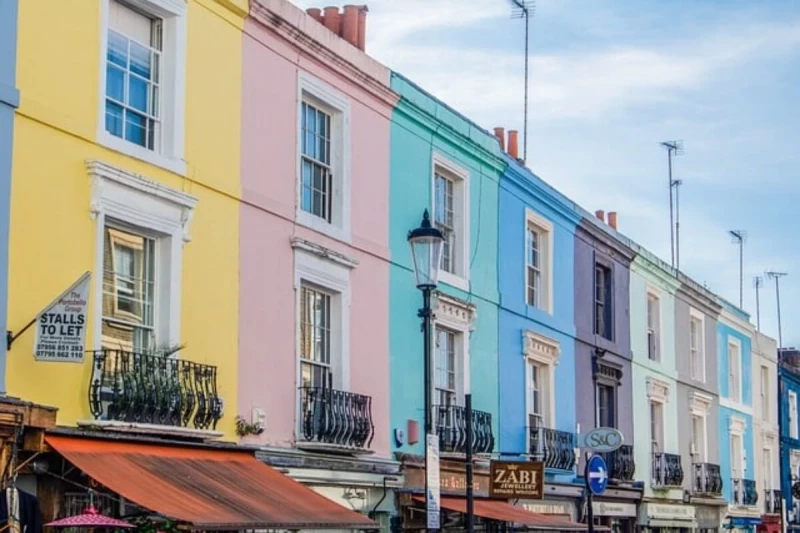
Notting Hill est un quartier dynamique et pittoresque situé dans l'ouest de Londres, en Angleterre. Célèbre pour ses maisons colorées, ses marchés animés et son atmosphère éclectique, Notting Hill est devenu une destination emblématique pour les visiteurs du monde entier.
Voici quelques caractéristiques et attractions clés de Notting Hill :
-
Marché de Portobello Road : Le marché de Portobello Road est l'un des marchés de rue les plus célèbres de Londres, réputé pour ses antiquités, ses vêtements vintage, ses stands de nourriture de rue et ses articles éclectiques. Le marché s'anime chaque samedi, attirant les habitants et les touristes pour parcourir ses étals et profiter de l'atmosphère animée.
-
Carnaval de Notting Hill : Notting Hill est le lieu du plus grand carnaval de rue d'Europe, le Carnaval de Notting Hill, qui a lieu chaque année le week-end du dernier lundi d'août. Le carnaval célèbre la culture caribéenne avec des costumes colorés, de la musique, de la danse et une délicieuse cuisine caribéenne, attirant des millions de visiteurs chaque année.
-
Maisons Colorées : Notting Hill est renommé pour ses rues pittoresques bordées de rangées de maisons colorées, peintes dans des tons pastel et ornées de façades charmantes. L'architecture vibrante ajoute au charme du quartier et en a fait un lieu prisé des amateurs de photographie.
-
Lieux de Tournage de Films : Le quartier a acquis une renommée internationale comme décor du film de comédie romantique "Notting Hill" avec Hugh Grant et Julia Roberts. Les fans du film peuvent visiter des lieux emblématiques comme la célèbre porte bleue de Portobello Road et d'autres sites de tournage dispersés dans le quartier.
-
Cafés et Restaurants Charmants : Notting Hill regorge de cafés confortables, de restaurants branchés et de restaurants pittoresques proposant une cuisine du monde entier. Que vous ayez envie de café artisanal, de plats britanniques traditionnels ou de délices internationaux, vous trouverez de nombreuses options culinaires pour satisfaire toutes les envies.
-
Espaces Verts : Notting Hill est entouré de magnifiques espaces verts, notamment Holland Park et Kensington Gardens, offrant aux résidents et aux visiteurs des retraites tranquilles au milieu de l'agitation de la vie urbaine.
En résumé, Notting Hill est un quartier vivant et diversifié qui offre un mélange unique de culture, d'histoire et de charme. Que vous exploriez ses marchés animés, admiriez ses maisons colorées ou appréciiez ses délices culinaires, Notting Hill est sûr de laisser une impression durable sur quiconque le visite.
13 - Hyde Park
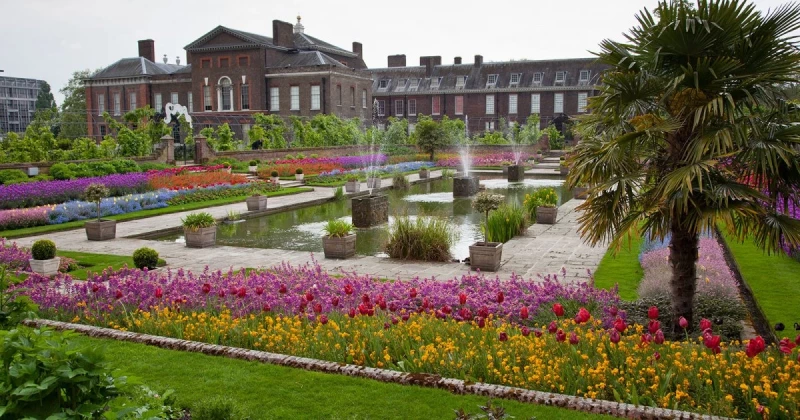
Hyde Park est l'un des parcs royaux les plus emblématiques de Londres, en Angleterre, et l'un des plus grands de la ville. Situé au cœur de Londres, Hyde Park offre un espace verdoyant et paisible où les visiteurs peuvent échapper à l'agitation de la vie urbaine et profiter de la nature.
Voici quelques points clés sur Hyde Park :
-
Taille et Aménagements : Hyde Park s'étend sur une superficie d'environ 142 hectares (350 acres) et propose une variété d'installations et d'activités pour les visiteurs. Les attractions comprennent des sentiers de promenade, des pelouses ouvertes pour pique-niquer et se détendre, des terrains de sport, des aires de jeux pour enfants, des fontaines, des jardins paysagers et même un lac appelé Serpentine.
-
Monuments et Points d'Intérêt : Hyde Park abrite plusieurs monuments et points d'intérêt, dont le célèbre Speakers' Corner, où les orateurs peuvent s'exprimer librement sur une variété de sujets, et le Diana, Princess of Wales Memorial Fountain, un mémorial dédié à la princesse Diana.
-
Activités : Les visiteurs de Hyde Park peuvent profiter d'une gamme d'activités, notamment la marche, la course à pied, le cyclisme, le roller, la navigation de plaisance sur le lac Serpentine, le tennis, le football et même l'équitation. Le parc offre également des possibilités d'observation des oiseaux et de détente au cœur de la nature.
-
Événements : Hyde Park accueille régulièrement des événements et des concerts en plein air, notamment des festivals de musique, des représentations théâtrales, des spectacles de cirque, des foires artisanales et des événements communautaires. Ces manifestations ajoutent à l'atmosphère animée du parc et attirent un large public.
-
Biodiversité : Hyde Park abrite une variété de faune et de flore, y compris des espèces d'oiseaux, de poissons, d'insectes et de plantes. Le parc est un sanctuaire pour la biodiversité au cœur de Londres, offrant un habitat vital pour de nombreuses espèces urbaines.
En résumé, Hyde Park est un joyau vert au cœur de Londres, offrant aux visiteurs un espace de détente, de loisirs et de découverte au milieu de l'effervescence de la ville. Que ce soit pour une promenade paisible, une activité sportive ou un événement culturel, Hyde Park offre quelque chose pour tout le monde, tout en préservant son caractère naturel et sa beauté intemporelle.
14 - Greenwich Park
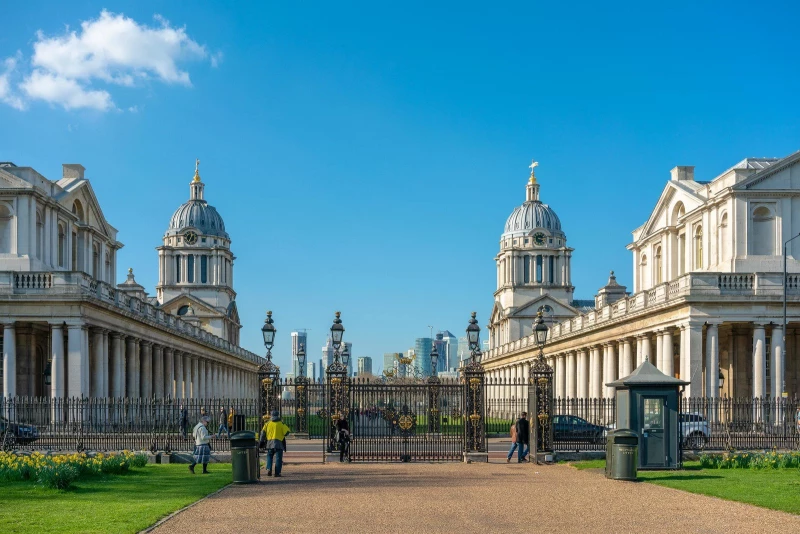
Greenwich Park est l'un des parcs royaux les plus emblématiques de Londres, situé dans le quartier de Greenwich, au sud-est de la ville. Voici quelques points clés sur Greenwich Park :
-
Histoire et Patrimoine : Greenwich Park possède une riche histoire remontant à l'époque romaine. Il est connu pour ses associations avec la royauté britannique et a été utilisé comme parc de chasse par les rois depuis le Moyen Âge. Le parc abrite également plusieurs monuments historiques, notamment le Royal Observatory, le Greenwich Meridian Line, et le Old Royal Naval College.
-
Vues Panoramiques : L'un des points forts de Greenwich Park est sa vue panoramique imprenable sur la ville de Londres. Du haut de la colline, les visiteurs peuvent profiter d'une vue spectaculaire sur Canary Wharf, le quartier financier de Londres, ainsi que sur les gratte-ciel de la City et d'autres sites emblématiques de la capitale.
-
Jardins et Paysages : Greenwich Park offre une variété de jardins magnifiquement entretenus, des pelouses verdoyantes, des parterres de fleurs colorées et des bosquets d'arbres. Les promeneurs peuvent se détendre dans ces espaces paisibles et profiter de la nature au cœur de la ville.
-
Activités : Les visiteurs de Greenwich Park peuvent participer à une gamme d'activités de plein air, notamment la marche, le jogging, le pique-nique, le cyclisme et le cerf-volant. Le parc est également un endroit populaire pour les familles, avec des aires de jeux pour enfants et des espaces ouverts pour jouer.
-
Événements et Festivals : Greenwich Park accueille régulièrement des événements et des festivals tout au long de l'année, notamment des concerts en plein air, des foires artisanales, des spectacles de théâtre et des célébrations communautaires. Ces événements ajoutent à l'atmosphère animée du parc et attirent un large public.
En résumé, Greenwich Park est un joyau naturel et historique qui offre aux visiteurs une escapade paisible loin de l'agitation de la ville. Avec ses vues panoramiques spectaculaires, ses jardins pittoresques et ses activités de plein air, le parc est une destination incontournable pour les habitants et les touristes à la recherche de tranquillité et de beauté naturelle à Londres.
15 - La gastronomie britanniques

La gastronomie britannique est diverse et riche en saveurs, reflétant l'histoire et la culture variée du Royaume-Uni. Voici un aperçu de certains plats et spécialités emblématiques de la cuisine britannique :
-
Fish and Chips : Ce plat classique est un incontournable de la cuisine britannique. Il se compose de morceaux de poisson, traditionnellement du cabillaud, panés et frits, servis avec des frites épaisses et souvent accompagnés de purée de petits pois ou de sauce tartare.
-
Sunday Roast : Le Sunday Roast, ou rôti du dimanche, est un repas traditionnellement servi le dimanche midi. Il se compose généralement d'une viande rôtie, comme du bœuf, de l'agneau ou du poulet, accompagnée de pommes de terre rôties, de légumes de saison, de Yorkshire pudding et de sauce au jus de viande.
-
Cottage Pie et Shepherd's Pie : Ces plats consistants sont des classiques de la cuisine britannique. La Cottage Pie est préparée avec de la viande de bœuf hachée et des légumes, recouverte d'une couche de purée de pommes de terre, tandis que la Shepherd's Pie utilise de l'agneau haché à la place du bœuf.
-
Full English Breakfast : Ce petit-déjeuner copieux comprend généralement des œufs (frits, brouillés ou pochés), des saucisses, du bacon, des haricots cuits, des tomates grillées, des champignons sautés, du black pudding (boudin noir) et des tranches de pain grillé.
-
Afternoon Tea : L'Afternoon Tea est une tradition britannique consistant à prendre une collation l'après-midi, généralement entre 15h00 et 17h00. Il comprend une sélection de thés, des sandwiches au concombre ou au saumon fumé, des scones avec de la crème et de la confiture, ainsi que des petits gâteaux et pâtisseries.
-
Plats régionaux : Chaque région du Royaume-Uni a ses propres spécialités culinaires. Par exemple, en Écosse, le Haggis est un plat traditionnel à base d'abats de mouton, tandis qu'au Pays de Galles, le Welsh Rarebit est une délicieuse tartine de fromage fondu sur du pain grillé.
En résumé, la gastronomie britannique offre une variété de plats délicieux et réconfortants, allant des classiques comme le Fish and Chips et le Sunday Roast aux spécialités régionales uniques. Que ce soit pour un repas copieux ou une collation raffinée, la cuisine britannique a quelque chose à offrir à tous les goûts.
16 - Faire une croisière sur la Tamise
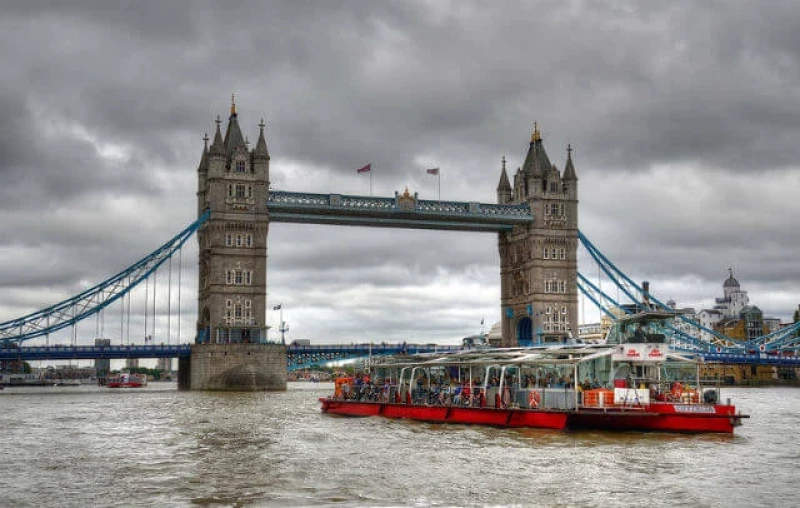
Faire une croisière sur la Tamise est une expérience incontournable lors d'une visite à Londres. Voici comment vous pouvez organiser cette activité :
-
Choisir une Compagnie de Croisière : Il existe plusieurs compagnies de croisière sur la Tamise à Londres, offrant différentes options de visites, de durées et de prix. Faites des recherches pour trouver celle qui correspond le mieux à vos préférences et à votre budget.
-
Réserver à l'Avance : Il est recommandé de réserver votre croisière à l'avance, surtout pendant les périodes de forte affluence touristique. Cela vous permettra de garantir votre place et parfois de bénéficier de réductions en ligne.
-
Choisir le Point de Départ : Les croisières sur la Tamise partent généralement de plusieurs points le long de la rivière, notamment Westminster Pier, Tower Pier, Greenwich Pier et Embankment Pier. Choisissez le point de départ qui vous convient le mieux en fonction de votre itinéraire et de vos intérêts.
-
Sélectionner le Type de Croisière : Les compagnies proposent différents types de croisières, allant des visites touristiques classiques aux croisières thématiques avec repas, musique en direct et commentaires audio. Choisissez celui qui correspond le mieux à ce que vous recherchez.
-
Profiter de la Croisière : Une fois à bord, détendez-vous et profitez de la croisière le long de la Tamise. Admirez les célèbres sites touristiques de Londres depuis un point de vue unique, y compris le Parlement, le London Eye, la Tour de Londres, la Cathédrale Saint-Paul et bien d'autres encore.
-
Écouter les Commentaires : Beaucoup de croisières proposent des commentaires audio en plusieurs langues pour vous renseigner sur les points d'intérêt le long de la rivière. Écoutez attentivement pour en apprendre davantage sur l'histoire et l'architecture de Londres.
-
Explorer les Arrêts : Selon l'itinéraire de votre croisière, vous pourriez avoir la possibilité de faire escale à certains arrêts, comme Greenwich, où vous pourrez visiter des attractions telles que le Cutty Sark, le Royal Observatory et le musée maritime.
En résumé, faire une croisière sur la Tamise est une façon agréable et relaxante de découvrir les principaux sites touristiques de Londres tout en profitant d'une vue panoramique depuis la rivière emblématique de la ville.
17 - Les studios Harry Potter
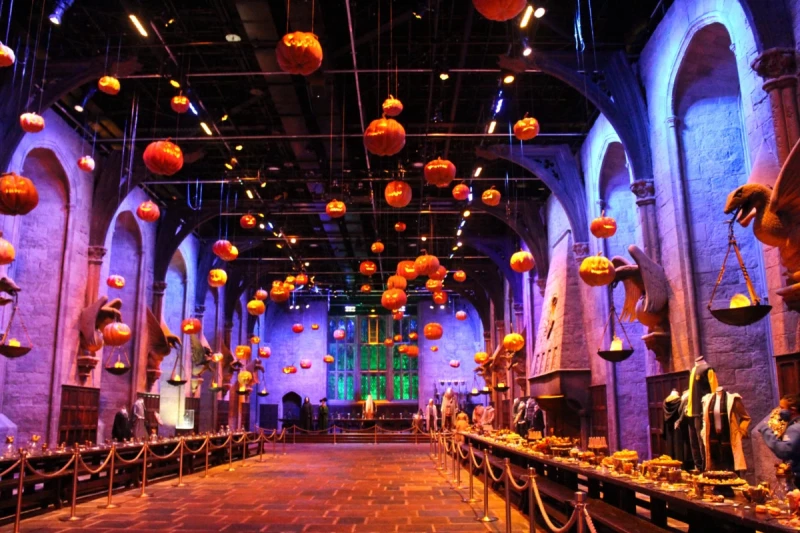
Ce lieu emblématique est situé dans les studios de Warner Bros. à Leavesden, en Angleterre. Il offre aux visiteurs une expérience immersive dans l'univers magique de la série de films Harry Potter.
Les studios offrent des visites guidées où les visiteurs peuvent explorer des décors authentiques, des costumes, des accessoires et des effets spéciaux utilisés dans les films. Les points forts incluent la Grande Salle de Poudlard, le Chemin de Traverse, le bureau de Dumbledore, la cabane de Hagrid et bien d'autres lieux emblématiques des films.
En plus des visites guidées régulières, les studios proposent également des événements spéciaux tout au long de l'année, comme des célébrations pour Noël, Halloween et d'autres occasions spéciales.
Les Warner Bros. Studios Tour London sont un incontournable pour les fans de Harry Potter qui souhaitent découvrir les coulisses de la création de ces films emblématiques.
 Nos astuces pour tirer le meilleur parti de votre expérience.
Nos astuces pour tirer le meilleur parti de votre expérience.
Pour visiter les studios Harry Potter depuis Londres, voici quelques étapes à suivre :
-
Réserver vos billets : Les billets pour les Warner Bros. Studio Tour London - The Making of Harry Potter doivent être réservés à l'avance, de préférence en ligne sur le site officiel. Les billets sont souvent vendus rapidement, surtout pendant les périodes de vacances et les week-ends, alors assurez-vous de réserver à l'avance pour garantir votre place.
-
Choisir votre mode de transport : Plusieurs options s'offrent à vous pour vous rendre aux studios depuis Londres. Vous pouvez prendre un train depuis la gare de Euston jusqu'à la gare de Watford Junction, puis prendre une navette spéciale qui vous emmènera directement aux studios. Une autre option est de réserver un transfert en bus ou une excursion organisée depuis le centre de Londres.
-
Planifier votre trajet : Assurez-vous de planifier votre trajet à l'avance, en tenant compte des horaires de départ et de retour des trains ou des navettes. Prévoyez suffisamment de temps pour profiter pleinement de votre visite aux studios, qui dure généralement environ trois à quatre heures.
-
Arriver tôt : Il est conseillé d'arriver tôt aux studios pour éviter les foules et avoir plus de temps pour explorer les différentes expositions et décors. Les horaires d'ouverture peuvent varier, alors vérifiez les horaires sur le site officiel avant de partir.
-
Profiter de la visite : Une fois sur place, profitez pleinement de votre visite des studios Harry Potter. Explorez les décors originaux, admirez les costumes et accessoires utilisés dans les films, découvrez les effets spéciaux et apprenez-en plus sur le processus de création des films.
-
Prendre des souvenirs : Ne manquez pas l'occasion de visiter la boutique de souvenirs des studios, où vous pourrez acheter une variété d'articles Harry Potter, des baguettes magiques aux vêtements en passant par les produits dérivés et les éditions spéciales des livres et des films.
-
Retour à Londres : Une fois votre visite terminée, retournez à Londres en suivant le même itinéraire que celui que vous avez emprunté à l'aller. Assurez-vous de consulter les horaires de retour des trains ou des navettes pour planifier votre voyage de retour.
En suivant ces étapes, vous pourrez profiter pleinement de votre visite des studios Harry Potter depuis Londres et vivre une expérience magique dans l'univers emblématique de Harry Potter.
18 - Faire une excursion vers le château de Windsor
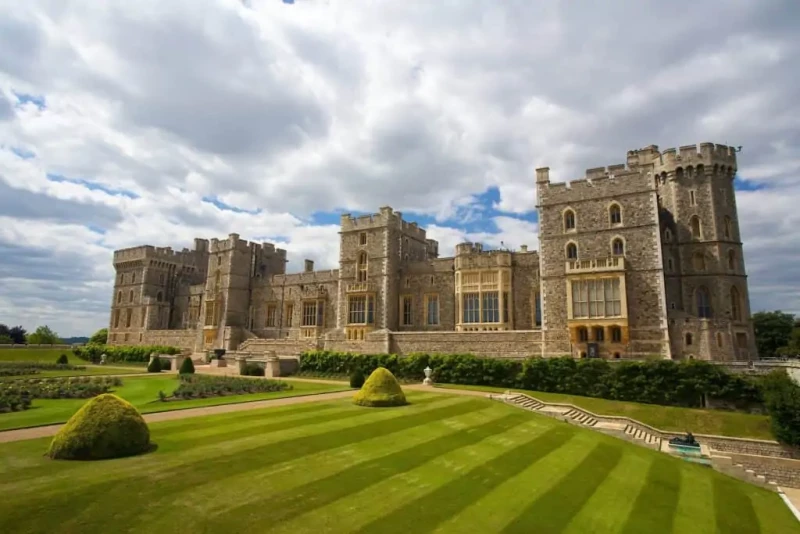
Faire une excursion vers le château de Windsor depuis Londres est une excellente idée, et c'est une excursion populaire pour les visiteurs de la capitale britannique. Voici comment vous pourriez organiser cette excursion :
-
Transport : Le moyen le plus courant de se rendre à Windsor depuis Londres est en train. Vous pouvez prendre un train depuis la gare de Paddington ou la gare de Waterloo jusqu'à la gare de Windsor & Eton Central. Le trajet dure environ 30 à 40 minutes. Alternativement, vous pouvez prendre un bus ou réserver une excursion en bus depuis Londres.
-
Billets d'entrée : Vous pouvez acheter des billets pour visiter le château de Windsor en ligne à l'avance ou à l'entrée du château. Il est recommandé d'acheter à l'avance pour éviter les files d'attente, surtout pendant les périodes de forte affluence touristique.
-
Visite du château : Une fois sur place, vous pourrez explorer le château à votre rythme. Ne manquez pas les points forts tels que la salle d'État, la chapelle Saint-Georges, les appartements semi-étatiques et les magnifiques jardins.
-
Temps libre : Après avoir visité le château, vous pouvez profiter de votre temps libre pour explorer la ville de Windsor. Vous pourriez vous promener dans les rues historiques, faire du shopping ou déjeuner dans l'un des nombreux restaurants locaux.
-
Retour à Londres : Assurez-vous de vérifier les horaires de retour des trains ou des bus pour vous assurer de rentrer à Londres à temps. Il est généralement conseillé de partir assez tôt pour éviter les heures de pointe du soir.
En suivant ces étapes, vous devriez pouvoir profiter d'une excursion agréable et mémorable au château de Windsor depuis Londres.
Londres - Où Loger ?
Pour choisir un endroit où séjourner à Londres lors d'une visite, il est important de considérer plusieurs facteurs, tels que votre budget, vos préférences en matière de transport, les attractions que vous souhaitez visiter et le type d'expérience que vous recherchez. Voici quelques quartiers populaires où séjourner à Londres, chacun offrant ses propres avantages :
-
West End: Ce quartier est idéal si vous souhaitez être au cœur de l'action, près des théâtres du West End, des boutiques de Covent Garden et des sites touristiques comme Trafalgar Square et Leicester Square. Les hébergements peuvent être un peu plus chers ici en raison de sa popularité.
-
South Bank: Situé le long de la rive sud de la Tamise, South Bank offre une vue magnifique sur les monuments emblématiques de Londres tels que le London Eye, le Tate Modern et le Shard. C'est un excellent choix pour ceux qui aiment une ambiance animée et qui veulent être près de la plupart des attractions principales.
-
Kensington et Chelsea: Ces quartiers sont réputés pour leur élégance et leur raffinement. Vous y trouverez des attractions telles que le Royal Albert Hall, le Musée d'Histoire Naturelle et le Palais de Kensington. Les hébergements peuvent être un peu plus chers ici, mais vous bénéficiez d'un accès facile aux transports en commun.
-
Camden: Si vous recherchez une atmosphère plus alternative et bohème, Camden pourrait être l'endroit idéal. Il est connu pour son marché éclectique, ses lieux de musique live et son ambiance jeune et dynamique.
-
Shoreditch: Ce quartier de l'est de Londres est réputé pour sa scène artistique, ses boutiques vintage, ses bars branchés et ses restaurants tendance. C'est un excellent choix pour les voyageurs à la recherche d'une ambiance plus alternative et créative.
-
Paddington et Bayswater: Ces quartiers sont bien situés et offrent souvent des options d'hébergement plus abordables. Ils sont bien desservis par les transports en commun et offrent un accès facile à des attractions telles que Hyde Park et le marché de Portobello Road.
-
Greenwich: Si vous préférez une ambiance plus tranquille, Greenwich pourrait être un bon choix. Vous y trouverez des attractions telles que le Royal Observatory, le Cutty Sark et le marché de Greenwich. Bien que légèrement en dehors du centre-ville, Greenwich est bien desservi par les transports en commun.
Quel que soit le quartier que vous choisissez, assurez-vous de vérifier la proximité des stations de métro ou de bus pour faciliter vos déplacements vers les attractions que vous souhaitez visiter. De plus, il est toujours utile de lire les avis et de comparer les prix des hébergements pour trouver l'option qui correspond le mieux à vos besoins et à votre budget.
Londres - Comment se déplacer ?
Pour vous déplacer et visiter Londres, vous avez plusieurs options de transport efficaces et pratiques :
-
Métro (Tube) : Le métro de Londres, appelé Tube, est l'un des systèmes de métro les plus étendus au monde. Il dessert la plupart des quartiers de la ville et est particulièrement utile pour se déplacer rapidement entre les différentes attractions. Assurez-vous d'acheter une carte Oyster ou d'utiliser une carte de transport sans contact pour bénéficier des tarifs réduits.
-
Autobus : Londres dispose d'un vaste réseau d'autobus qui couvre toute la ville. Les bus offrent une option de transport pratique pour atteindre des endroits non accessibles par le métro. Vous pouvez également utiliser la carte Oyster ou une carte de transport sans contact pour payer votre trajet en bus.
-
Train : En plus du métro, Londres a un réseau de trains de banlieue qui dessert les zones périphériques de la ville ainsi que les villes voisines. Ces trains peuvent être utiles si vous prévoyez de visiter des attractions en dehors du centre de Londres.
-
Train Docklands Light Railway (DLR) : Le DLR est un système de métro léger automatisé qui dessert les quartiers de Canary Wharf, Greenwich et Stratford. Il offre un moyen pratique de se déplacer dans ces zones.
-
Vélo : Le système de location de vélos de Londres, connu sous le nom de Santander Cycles, permet aux visiteurs de louer des vélos pour explorer la ville. Il y a de nombreuses pistes cyclables à Londres, ce qui en fait une option agréable pour ceux qui aiment explorer la ville à leur rythme.
-
Marche à pied : Londres est une ville relativement compacte et de nombreuses attractions sont situées à distance de marche les unes des autres, en particulier dans le centre-ville. La marche à pied est souvent la meilleure façon de découvrir les quartiers pittoresques et les petites rues de la ville.
-
Taxi et services de covoiturage : Les taxis noirs londoniens emblématiques sont facilement disponibles dans toute la ville, tout comme les services de covoiturage comme Uber et Lyft. Ils peuvent être utiles pour les trajets plus courts ou lorsque vous avez besoin d'un transport direct vers une destination spécifique.
En résumé, Londres offre une variété d'options de transport qui rendent la ville facile à explorer pour les visiteurs. En utilisant une combinaison de métro, d'autobus, de train, de vélo et de marche à pied, vous pourrez découvrir facilement les nombreux sites et attractions qu'elle a à offrir.
Londres - Meilleure période
London peut être visitée toute l'année, mais le meilleur moment dépend de vos préférences en matière de météo, de foules et d'événements. Voici un aperçu des saisons :
-
Printemps (mars à mai) : Le printemps à Londres apporte des températures douces, des fleurs en pleine floraison et des journées plus longues. C'est un moment idéal pour explorer les parcs, les jardins et les attractions extérieures sans les foules estivales. Gardez à l'esprit qu'avril tend à être un peu pluvieux, donc emportez un parapluie.
-
Été (juin à août) : L'été est la haute saison touristique à Londres, avec de longues journées, des températures plus chaudes et une ambiance animée. C'est le moment des festivals en plein air, des événements et des repas en terrasse. Cependant, soyez prêt à affronter des foules plus importantes et des prix plus élevés pour les hébergements et les attractions.
-
Automne (septembre à novembre) : L'automne est une belle saison pour visiter Londres, car les parcs et les rues de la ville sont peints de couleurs automnales vibrantes. Le temps reste doux en septembre et début octobre, ce qui est idéal pour le tourisme. De plus, cette saison attire moins de touristes par rapport aux mois d'été.
-
Hiver (décembre à février) : L'hiver à Londres est frais et peut être humide, mais la ville prend une ambiance festive avec ses marchés de Noël, ses décorations et ses patinoires. Janvier et février sont généralement les mois les plus froids, mais vous trouverez moins de foule et de meilleures offres sur les hébergements. De plus, des attractions comme les musées et les théâtres restent ouvertes toute l'année.
En fin de compte, le meilleur moment pour visiter Londres dépend de vos intérêts et de ce que vous souhaitez vivre pendant votre voyage. Si vous préférez un temps doux et des foules moins importantes, envisagez de visiter pendant les saisons intermédiaires du printemps et de l'automne. Cependant, si vous voulez vivre l'excitation des festivals estivaux ou le charme festif de l'hiver à Londres, planifiez votre voyage en conséquence.
